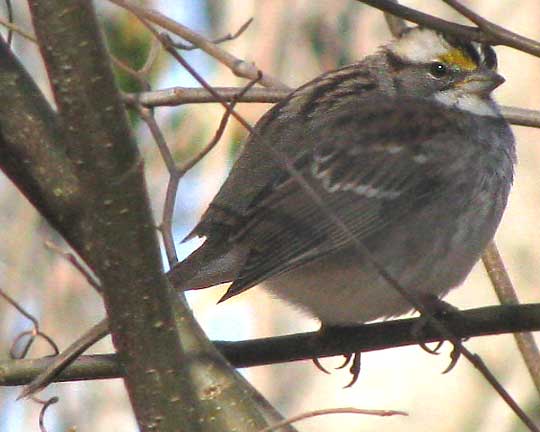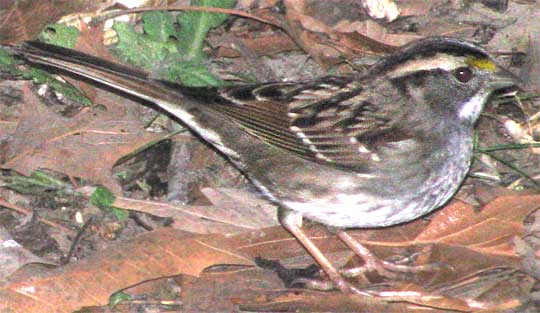Excerpts from Jim Conrad's
Naturalist Newsletter
from the February 9, 2009 Newsletter, issued from the forest near Natchez, Mississippi; elevation ~400ft (120m), ~N31.47°, ~W91.29°:
ALL FLUFFED OUT
Nowadays around here temperatures bounce between extremes. This week during a couple of dawn breakfasts it was 25°F (-4°C) but on recent afternoons the thermometer showed 75°F (24°C) and now frogs are calling all night long. On one of our frosty mornings earlier this week a White-throated Sparrow, ZONOTRICHIA ALBICOLLIS, took up a perch beside my trailer as I built my campfire and for me his demeanor and fluffed-out feathers reflected the morning's hunkering-down-but-satisfied feeling, as shown below:

White-throated Sparrows are strictly winter visitors here, during summers occupying mainly the forested zones of eastern and central Canada and the adjacent US. I'll bet that many of you in the US currently have little flocks of this sparrow gleaning seeds beneath your bird feeders.
As spring comes closer and birds begin taking on brighter colors, those of you with backyard White- throated Sparrows might want to familiarize yourselves with the species' "white-striped morph" and "tan-striped morph" situation. A "morph" is a distinct form of a single species, and among White-throated Sparrows the two morphs are both common, though they can be hard to distinguish when the species is in its dull winter plumage. I think but am not sure that my fluffed-out bird above is a white-striped morph. Sunday morning right before the sun came up some White-throated Sparrows and Dark-eyed Juncos were foraging around my campfire area and possibly the picture I took with a flash shows a "tan-striped" below:

Notice the "tan-striped's" slightly tan eye-stripe and less pronounced yellow spot before the eye. If someone has more experience distinguishing these morphs let me know because I'd like to get this straight.
An interesting feature about the morphs is that "white-striped" females are more aggressive than tan- striped ones, and thus are preferred by males of both forms. "Tan-striped" males seem to be preferred as partners by females of both morphs however, so this leaves "white-striped" males and "tan-striped" females to pair with each other. The result in the whole population is that about 96% of all pairings are mixed-morph ones.
You can see the two morphs as well as its "first winter plumage," and read more about the morph situation (under "Cool Facts") at Cornell University's page here.